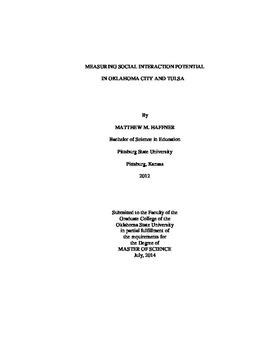| dc.description.abstract | Social degradation is now a serious problem in cities in the United States. People are interacting with their neighbors, families, and those within their community less frequently. Some major causes of this are central city decline, urban sprawl, and suburbanization. People within cities are now farther away from each other and from activity locations, making social interaction more difficult. Recently, time geography has researchers rethinking traditional approaches to these topics along with studies in transportation, accessibility, and mobility. This subdiscipline of geography is based on an individualized approach that incorporates the constraints that all humans face on a day-to-day basis. In my thesis I evaluate the social interaction potential (SIP) of working populations in the urbanized areas of Oklahoma City and Tulsa, focusing on coupling constraints that limit the opportunities for individuals to meet face-to-face at certain activity locations and interact with each other. Using restaurants as activity locations, I calculate the amount of time that can potentially be spent interacting with others at activity locations based on different combinations of work locations and home locations within the two cities. Several variables strongly affect the calculation of SIP such as the population within each zone, the driving time to activity locations, and the distance from all other zones. While Oklahoma City and Tulsa are similar in terms land area, population, restaurant location distribution, and recent capital improvement projects, the two have different urban forms which affect the patterns of SIP. While there is generally more SIP near the center of both cities, Oklahoma City shows a more dispersed and sectoral pattern with "fingers" of SIP extending from the downtown area, while Tulsa shows a more central city phenomenon with high concentration of SIP in the center and a steep drop off in SIP away from the center. | |
